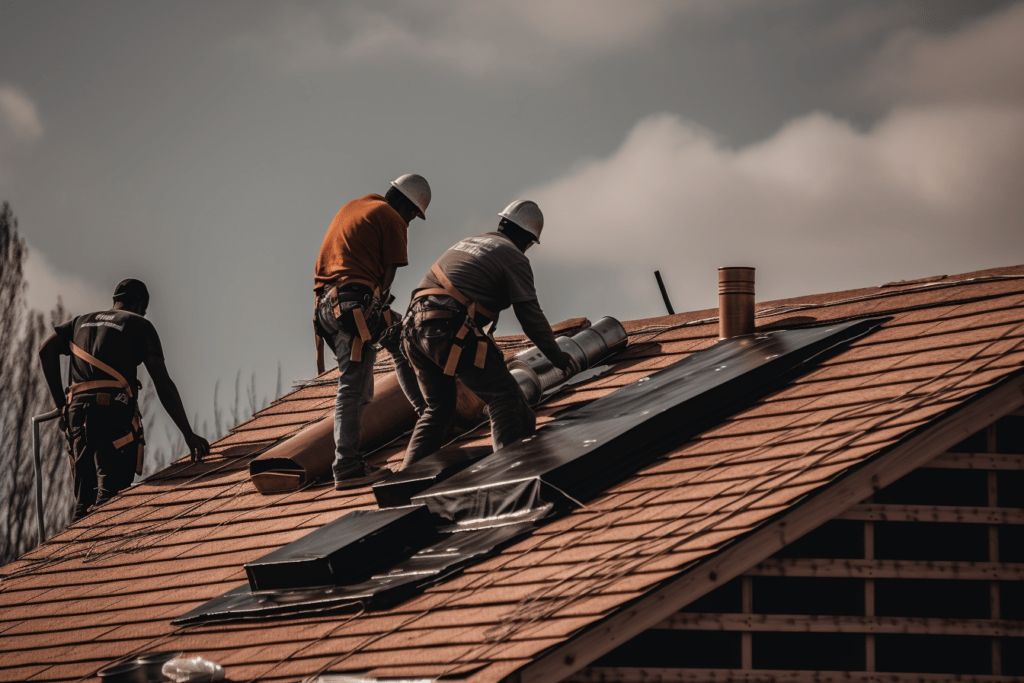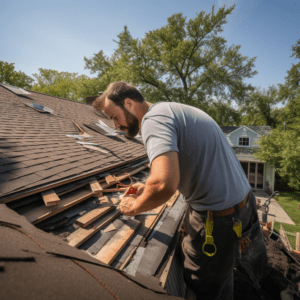Like a shield protecting a fortress, the roof safeguards a home from external elements. However, conventional roofing materials can have detrimental effects on the environment and contribute to energy inefficiency. This article explores the benefits of eco-friendly roofing choices, including sustainable materials, energy-efficient options, and green roof solutions for urban areas. By examining installation and maintenance tips, as well as the environmental impact of conventional roofing materials, readers will gain practical knowledge in selecting eco-friendly roofs that not only benefit the planet but also offer long-term savings.
Key Takeaways
- Eco-friendly roofing choices can lead to reduced energy consumption and decreased greenhouse gas emissions.
- Sustainable roofing materials like metal, rubber, clay, and vegetation offer various benefits such as durability, fire resistance, and improved insulation.
- Energy-efficient roofing options like cool roofs and green roofs can help keep buildings cooler, regulate temperature fluctuations, and reduce the need for mechanical heating or cooling systems.
- Green roofing solutions have multiple advantages such as mitigating stormwater runoff, improving water quality, providing habitat opportunities for urban wildlife, and capturing pollutants to improve air quality.
Benefits of Eco-Friendly Roofing
The benefits of eco-friendly roofing include reduced energy consumption, decreased greenhouse gas emissions, and improved indoor air quality. Eco-friendly roofs are designed to minimize heat absorption and maximize heat reflection, resulting in lower cooling costs during the summer months. By reducing the amount of energy needed for air conditioning, eco-friendly roofs can significantly decrease overall energy consumption and contribute to long-term energy savings.
Eco-friendly roofs help reduce greenhouse gas emissions. Traditional roofing materials such as asphalt shingles absorb and retain heat, contributing to the urban heat island effect. In contrast, eco-friendly roofs reflect a greater amount of solar radiation back into the atmosphere, reducing both surface and ambient temperatures. This reduction in temperature helps mitigate climate change by lowering carbon dioxide emissions associated with energy production.
Furthermore, eco-friendly roofing materials improve indoor air quality. Many conventional roofing materials contain harmful chemicals such as volatile organic compounds (VOCs) that can be released into the air over time. These VOCs contribute to poor indoor air quality and pose health risks to occupants. Eco-friendly roof options such as metal or clay tiles are free from VOCs and provide a healthier living environment.
Types of Sustainable Roofing Materials
Metal, rubber, and clay are some examples of sustainable materials commonly used for roofs. Metal roofing is known for its longevity and durability. It can last up to 50 years or more with minimal maintenance. It is also fire-resistant, energy-efficient, and recyclable at the end of its life cycle. Rubber roofing, usually made from recycled tires, offers excellent water resistance and durability. It is lightweight and easy to install, making it a popular choice for flat roofs. Additionally, rubber roofing has good insulating properties and can help reduce energy consumption. Clay tiles have been used as roofing materials for centuries due to their natural beauty and longevity. They are resistant to fire, insects, mold, and decay. Clay tiles are also environmentally friendly as they can be recycled after use.
Another sustainable material gaining popularity in recent years is green roofs or living roofs. These roofs consist of a layer of vegetation grown on top of a waterproof membrane. Green roofs provide numerous benefits such as improved insulation, reduced storm water runoff, increased biodiversity, and improved air quality.
Energy-Efficient Roofing Options
Energy-efficient roofing options contribute to reducing energy consumption and improving the overall sustainability of building construction. By implementing energy-efficient roofing materials and techniques, buildings can reduce their reliance on artificial heating and cooling systems, thereby decreasing their carbon footprint.
One energy-efficient roofing option is cool roofs. These roofs are designed to reflect more sunlight and absorb less heat compared to traditional roof materials. Cool roofs typically have a higher solar reflectance, which means they reflect a greater amount of solar radiation back into the atmosphere. This helps to keep the building cooler during hot summer months by reducing heat absorption through the roof.
Another option is green roofs or living roofs, which involve covering the roof with vegetation. Green roofs provide insulation benefits by acting as an additional layer of protection from temperature extremes. The plants and soil help to regulate temperature fluctuations, reducing the need for mechanical heating or cooling systems.
Additionally, photovoltaic (PV) panels can be integrated into roofing systems to generate renewable electricity from sunlight. PV panels convert solar energy into electrical power that can be used directly within the building or fed back into the grid.
Overall, incorporating energy-efficient roofing options not only reduces energy consumption but also helps mitigate climate change by decreasing greenhouse gas emissions associated with artificial heating and cooling systems in buildings.
The Importance of Green Roofing
Green roofing is an effective strategy for enhancing building sustainability and reducing the environmental impact of construction. It involves the installation of a living, vegetated layer on top of a building’s roof, providing numerous benefits to both the environment and the occupants. One key advantage of green roofing is its ability to mitigate stormwater runoff. The vegetation and soil act as natural filters, absorbing rainfall and reducing the amount of water that flows into storm drains and local waterways. This helps prevent flooding, reduces strain on municipal infrastructure, and improves water quality.
Another significant benefit is green roofing’s positive impact on energy efficiency. The vegetation layer acts as insulation, reducing heat transfer between the building and its surroundings. This can lead to lower heating and cooling costs throughout the year. Additionally, green roofs absorb solar radiation, further decreasing indoor temperatures during hot weather.
Furthermore, green roofing provides habitat opportunities for urban wildlife by creating pockets of green space in otherwise developed areas. It also helps improve air quality by capturing pollutants from the atmosphere through plant leaf surfaces.
Eco-Friendly Roofing Solutions for Urban Areas
One alternative option for sustainable roof construction in urban areas involves the use of natural materials that are locally sourced and have a low carbon footprint. This approach aims to reduce the environmental impact of roofing systems by utilizing materials that are readily available and do not require extensive transportation, thereby minimizing carbon emissions associated with production and delivery. Natural materials such as clay tiles, slate, thatch, bamboo, and wood can be used for eco-friendly roofs.
Clay tiles are a popular choice due to their durability, thermal insulation properties, and ability to withstand extreme weather conditions. Slate is another viable option known for its longevity and resistance to fire. Thatch roofs made from dried vegetation provide excellent insulation against heat transfer while also being aesthetically pleasing. Bamboo offers a sustainable alternative with its rapid regrowth rate compared to traditional timber options. Wood shingles or shakes sourced from sustainably managed forests can also be utilized for green roofs.
In addition to the use of natural materials, incorporating green infrastructure elements like rainwater harvesting systems and rooftop gardens further enhances the sustainability of urban roofs. These features help manage stormwater runoff, improve air quality, mitigate urban heat island effects, promote biodiversity, and create spaces for recreational activities.
Overall, adopting eco-friendly roofing solutions in urban areas through the use of locally sourced natural materials not only reduces the carbon footprint but also contributes towards creating healthier and more sustainable cities.
Cost-Effective Green Roofing Alternatives
This discussion will focus on sustainable roofing materials and their potential for long-term energy savings. Sustainable roofing materials refer to options that are environmentally friendly, recyclable, and have a lower carbon footprint compared to traditional roofing materials. These materials not only contribute to the overall sustainability of a building but also offer potential energy savings by reducing heat transfer, improving insulation properties, and facilitating rainwater harvesting systems.
Sustainable Roofing Materials
Sustainable roofing materials are widely recognized as a viable option for achieving eco-friendly and energy-efficient building designs. These materials not only minimize the negative impact on the environment but also provide long-term cost savings. One such material is metal roofing, which offers durability, recyclability, and energy efficiency. Metal roofs have a lifespan of 40-70 years, reducing the need for frequent replacements. Additionally, they can be made from recycled materials and are fully recyclable at the end of their life cycle. Another sustainable option is solar roofing, which integrates photovoltaic panels into traditional roofing materials. Solar roofs generate clean electricity while providing protection from the elements. Other eco-friendly options include green roofs with vegetation that improve insulation and reduce stormwater runoff. Sustainable roofing materials offer practical solutions for constructing environmentally friendly buildings while also promoting energy efficiency and cost-effectiveness.
Long-Term Energy Savings
Metal roofing and solar roofing are two options that can provide long-term energy savings. Metal roofing is known for its durability, longevity, and ability to reflect heat, reducing the need for air conditioning during hot weather. It is also recyclable at the end of its life cycle, making it an eco-friendly choice. Solar roofing integrates solar panels into the roof structure, allowing for the generation of electricity from sunlight. This renewable energy source can significantly reduce or eliminate dependence on traditional electrical grids, resulting in long-term savings on utility bills. Additionally, solar roofing systems often come with warranties lasting 20 to 25 years, ensuring continued energy savings over a significant period. While both options may require initial investments, their potential for long-term energy savings makes them appealing choices for environmentally conscious individuals looking to reduce their carbon footprint and save money in the long run.
How to Choose the Right Eco-Friendly Roofing for Your Home
This discussion will focus on two key points when choosing eco-friendly roofing for your home: material durability and sustainability, as well as energy efficiency and savings. Material durability and sustainability are important factors to consider because they determine the lifespan of the roof and its impact on the environment. Energy efficiency is crucial for reducing energy consumption and saving money on utility bills in the long run. By understanding these aspects, homeowners can make informed decisions about which eco-friendly roofing options best suit their needs.
Material Durability and Sustainability
Material durability and sustainability are important factors to consider when choosing eco-friendly roofing options. When it comes to material durability, it is crucial to select a roofing material that can withstand the elements and provide long-lasting protection for your home. Some durable options include metal roofs, which have a lifespan of 40-70 years, and clay or concrete tiles, which can last up to 100 years with proper maintenance. In terms of sustainability, it is essential to choose materials that are made from renewable resources or recycled materials. For example, cedar shingles are sourced from sustainably managed forests and have a natural resistance to decay and insects. Additionally, rubber roofing made from recycled tires offers excellent durability while reducing waste in landfills. By considering both material durability and sustainability, you can make an informed decision on the best eco-friendly roofing option for your needs.
Energy Efficiency and Savings
When considering energy efficiency and savings in the context of roofing options, it is important to evaluate factors such as insulation properties and solar reflectance. Insulation plays a crucial role in reducing heat transfer through the roof, thereby minimizing the need for artificial heating or cooling. An effective insulation material can significantly lower energy consumption and subsequently decrease utility costs. Additionally, solar reflectance refers to a roofing material’s ability to reflect sunlight rather than absorbing it. Roofs with high solar reflectance reduce heat buildup within buildings, leading to reduced cooling loads during hot weather conditions. This feature can contribute to substantial energy savings by decreasing reliance on air conditioning systems. Therefore, when selecting roofing materials, prioritizing those with excellent insulation properties and high solar reflectance can greatly enhance energy efficiency and result in long-term cost savings for building owners.
Green Roofing Installation and Maintenance Tips
To ensure successful installation and maintenance of green roofing, it is essential to follow recommended guidelines and practices. Green roofs are a sustainable roofing choice that provide numerous environmental benefits, such as reducing stormwater runoff, improving air quality, and mitigating the urban heat island effect. When installing a green roof, it is important to consider factors such as building structure compatibility, weight-bearing capacity, and waterproofing. The roof should be inspected to ensure it is in good condition before installing any vegetation or drainage layers.
The first step in green roof installation is to prepare the roof surface by removing any existing vegetation and debris. Next, a waterproof membrane should be applied to prevent water leakage into the building. A root barrier should also be installed to protect the roofing system from plant roots penetrating into the underlying layers.
After these preparatory steps are completed, a drainage layer should be installed to allow excess water to drain away from the plants’ roots. This layer can consist of materials such as lightweight aggregate or geotextile fabric with perforated pipes for efficient water flow.
Once the drainage layer is in place, a filter fabric can be added on top to prevent fine particles from clogging the drainage system. A growing medium suitable for plants should then be carefully spread over the filter fabric.
Finally, select appropriate plant species that are suitable for the local climate conditions and maintain them regularly by providing adequate irrigation and fertilization as needed. Regular inspections should also be conducted to identify and address any potential issues such as pest infestations or plant diseases.
Environmental Impact of Conventional Roofing Materials
Conventional roofing materials can have significant negative environmental impacts, including contributing to urban heat island effect and increasing energy consumption for cooling. The use of materials such as asphalt shingles and metal roofs can contribute to the urban heat island effect by absorbing and retaining heat, thereby raising the temperature in urban areas. This increase in temperature not only affects the comfort of individuals but also increases energy consumption for cooling buildings.
Asphalt shingles, one of the most commonly used roofing materials, are made from petroleum-based products. The extraction and refinement of petroleum contribute to greenhouse gas emissions and air pollution. Additionally, asphalt shingles have a relatively short lifespan compared to other roofing options, resulting in more waste being sent to landfills.
Metal roofs, although durable and long-lasting, also have negative environmental impacts. The production process requires large amounts of energy and generates greenhouse gas emissions. Furthermore, metal roofs tend to conduct heat quickly, which can result in higher energy usage for cooling purposes.
To mitigate these environmental impacts, alternative eco-friendly roofing choices should be considered. Options such as green roofs or cool roofs can help reduce the urban heat island effect and decrease energy consumption for cooling buildings. Green roofs involve covering rooftops with vegetation that provides insulation properties while reducing stormwater runoff. Cool roofs incorporate light-reflective materials that minimize heat absorption from sunlight.
Long-Term Savings With Eco-Friendly Roofing
This discussion focuses on the cost-effective sustainability options, energy-efficient roofing materials, and environmental benefits of eco-roofs. Cost-effective sustainability options refer to roofing choices that not only contribute to environmental preservation but also provide long-term savings for homeowners or building owners. Energy-efficient roofing materials are designed to reduce heat transfer and improve insulation, resulting in lower energy consumption and reduced utility costs. Additionally, eco-roofs offer various environmental benefits such as stormwater management, improved air quality, and habitat creation.
Cost-Effective Sustainability Options
One cost-effective sustainability option for eco-friendly roofing is the use of recycled materials such as reclaimed wood or plastic. These materials offer several benefits in terms of both environmental impact and cost-effectiveness. Reclaimed wood, for example, can be sourced from old barns or demolished buildings, reducing the need for new timber and minimizing deforestation. Similarly, using recycled plastic can divert waste from landfills while also reducing the demand for new plastics production. Additionally, these recycled materials are often more affordable compared to their non-recycled counterparts, making them a practical choice for homeowners and businesses looking to implement sustainable roofing solutions without breaking the bank. By opting for recycled materials in roofing projects, individuals can contribute to a greener future while enjoying cost savings at the same time.
Energy-Efficient Roofing Materials
Energy-efficient roofing materials can significantly reduce energy consumption in buildings by minimizing heat transfer and reducing the need for excessive heating or cooling. These materials are designed to reflect solar radiation, preventing the absorption of heat into the building. One popular option is cool roofs, which use reflective coatings or tiles to minimize heat gain. Another option is green roofs, which incorporate vegetation on rooftops to provide insulation and absorb sunlight. Additionally, thermal insulation materials such as rigid foam boards or spray polyurethane foam can be installed under the roof to further reduce heat transfer. It is important to consider factors such as climate, building design, and cost when selecting energy-efficient roofing materials. Proper installation and maintenance are also crucial for maximizing their effectiveness in reducing energy consumption and improving overall building efficiency.
Environmental Benefits of Eco-Roofs
Energy-efficient roofing materials not only provide benefits in terms of reducing energy consumption and costs, but they also offer significant environmental advantages. Eco-roofs, or green roofs, are a type of eco-friendly roofing choice that can contribute to a healthier environment. These roofs consist of vegetation planted on top of a waterproof membrane, providing numerous environmental benefits. Firstly, eco-roofs help reduce the urban heat island effect by absorbing and deflecting solar radiation. This helps to lower ambient temperatures in cities and mitigate the demand for air conditioning during hot summer months. Additionally, green roofs improve air quality by capturing airborne pollutants and carbon dioxide while releasing oxygen through photosynthesis. Furthermore, these roofs retain rainwater and mitigate stormwater runoff, reducing strain on sewer systems and helping to prevent flooding. Overall, eco-roofs serve as an effective solution for promoting environmental sustainability in urban areas.




